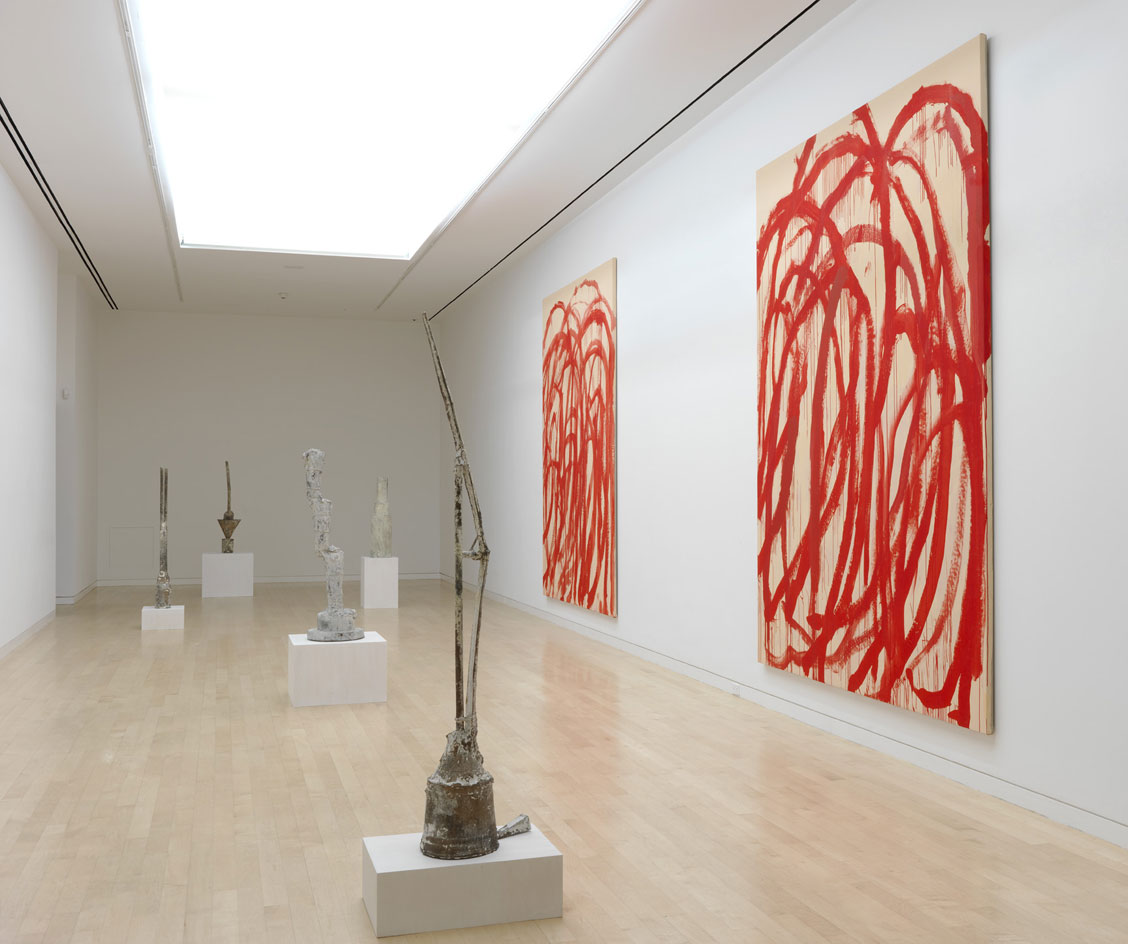Cy's the limit: Gagosian's soaring Twombly exhibition

'I get very stimulated by architecture,' said Cy Twombly in a rare interview in 2007. 'I always liked the little gallery, the uptown gallery. It's just the right space.' That very space - Gagosian's Upper East Side gallery - is currently home to an exhibition of some of the artist's last works, many of them on public view for the first time.
The elegiac quality that has always haunted Twombly's oeuvre, seeded with fragments of antiquity he once described as 'scratching and biting into the canvas,' reaches a triumphantly bittersweet climax. On display here are five large paintings and eight sculptures, created in the years before Twombly's death in 2011 at the age of 83.
The gallery's prime sixth-floor space is dominated by 'Blooming' (2001-2008), a ten-panel painting that belongs to Twombly's 'A Scattering of Blossoms' series. This exploded bouquet is composed of scarlet peonies that bob, weave, and punch their way through a white ground. They float, bruised and stemless, trailed by slender drips of red and surrounded by fading ghost blossoms, flashes of fiery orange, and outlined buds-in-progress.
For Twombly, this body of late work was inextricable from the physical demands of his preferred grand scale ('Blooming' spans nearly 3 metres and stands at 1.5 metres tall). 'Due to a certain physicality, or lack of breath from standing, [I] work in ...an impatient way. It has to be done and I take liberties I wouldn't have taken before,' he said. 'Like in those flower paintings, if I didn't like what I was doing, I just did round it without even looking to cover it out. I got all kinds of wonderful effects that I never achieved before. They all have beautiful passages, such large passages, not like those early paintings.'
The horizontal field of peonies is flanked by two untitled vertical canvases from 2008, both approximating ten lines of cursive script written in white on deep blue tablets made moodier by visible brushstrokes. Positioned opposite one another, these paintings reveal their distinct characters: one more orderly, the other threatening spiraled chaos; one sputtering out in a bottom row of splattered dots, the other suggesting a beach at night, with the ghost of a horizon visible through the looped skeins of pseudo-writing.
Twombly's ability to sustain and further his blurring of figuration and abstraction, lament and reverie in three dimensions is the revelation of his sculptures, the subject of an excellent recent monograph by Kate Nesin. Aside from a tiered teal assemblage of plaster, wood, nails, and iron, the sculptures here are bronze, in weathered hues of cream, chalk, and bleached ochre. They are human-scaled ('Small, because I like to be able to carry them, by myself,' Twombly said) and evoke, at turns, prehistoric sand castles, tribal monuments, and elegant avian postures built from quotidian components: boxes, buckets, axes, pipes.
In his review of a 1955 Twombly show, poet and critic Frank O'Hara praised the 'admirably esoteric information' and 'remarkable feelings' of the paintings, devoting only a lone final sentence to the sculptures. He described them as 'witty and funereal,' a pair of adjectives that take on new meaning six decades later in a space that Twombly loved.

Many of the 13 works on show have never been exhibited before. © Cy Twombly Foundation; Courtesy Gagosian Gallery

'Blooming' by Cy Twombly, 2001-2008. © Cy Twombly Foundation; Collection Cy Twombly Foundation

'Untitled' by Cy Twombly, 2004-2009. © Cy Twombly Foundation; Collection Cy Twombly Foundation; Courtesy Gagosian Gallery

'Untitled' by Cy Twombly, 2004. © Cy Twombly Foundation; Collection Cy Twombly Foundation; Courtesy Gagosian Gallery
ADDRESS
Gagosian Madison Avenue
980 Madison Avenue
New York
NY 10075
Receive our daily digest of inspiration, escapism and design stories from around the world direct to your inbox.
Stephanie Murg is a writer and editor based in New York who has contributed to Wallpaper* since 2011. She is the co-author of Pradasphere (Abrams Books), and her writing about art, architecture, and other forms of material culture has also appeared in publications such as Flash Art, ARTnews, Vogue Italia, Smithsonian, Metropolis, and The Architect’s Newspaper. A graduate of Harvard, Stephanie has lectured on the history of art and design at institutions including New York’s School of Visual Arts and the Institute of Contemporary Art in Boston.
-
 Ballman Khaplova creates a light-filled artist’s studio in upstate New York
Ballman Khaplova creates a light-filled artist’s studio in upstate New YorkThis modest artist’s studio provides a creative with an atelier and office in the grounds of an old farmhouse, embedding her practice in the surrounding landscape
-
 Italy’s most famous recipe book gets a revamp for its latest edition
Italy’s most famous recipe book gets a revamp for its latest edition‘Il Cucchiaio d'Argento’, or ‘The Silver Spoon’, is Italy's best-known recipe book: artist Olimpia Zagnoli and cultural design studio Bunker collaborated on a new look for its latest edition
-
 Messika marks 20 years with a high jewellery collection inspired by Namibia
Messika marks 20 years with a high jewellery collection inspired by NamibiaThe Terres d’Instinct high jewellery collection, unveiled at Paris Fashion Week, is a riot of colour and bold forms